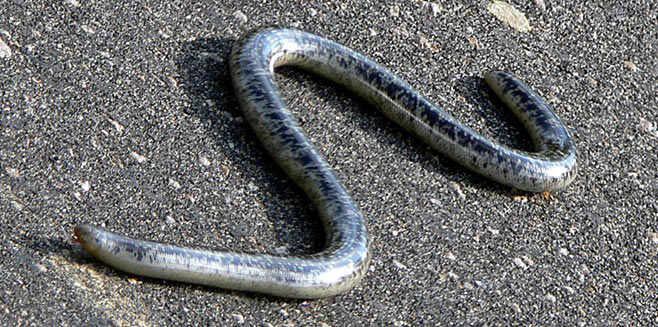|
Rhinotyphlops schlegelii (Schlegel's beaked blind snake)
Schlegel se haakneusblindslang [Afrikaans]
Life >
Eukaryotes
>
Opisthokonta >
Metazoa
(animals) > Bilateria > Deuterostomia >
Chordata >
Craniata > Vertebrata (vertebrates) > Gnathostomata (jawed vertebrates) >
Teleostomi (teleost fish) > Osteichthyes (bony fish) > Class:
Sarcopterygii (lobe-finned fish) > Stegocephalia (terrestrial vertebrates) >
Tetrapoda
(four-legged vertebrates) > Reptiliomorpha > Amniota >
Reptilia (reptiles) >
Romeriida > Diapsida > Lepidosauromorpha > Lepidosauria >
Squamata > Serpentes
(snakes) > Family: Typhlopidae > Genus:
Rhinotyphlops
 |
|
Rhinotyphlops schlegelii (Schlegel's beaked blind snake) [photo Arno Meintjes
©] |
Identification
Schlegel's beaked blind snake can be identified by it
relatively large size, a beaked snout and small yet prominent eyes. It grows to
an average length of 60 cm but may reach up to 1 meter in length.
Distribution and habitat
Found in Mpumalanga, Limpopo and southern
Mozambique. Its favoured habitats are coastal forest and moist savanna.
Food
Predominately eats
termites and other invertebrates.
Predators, parasites and disease
Eaten by other snakes.
Reproduction
Oviparous (egg-laying), lays between 8 and 60 eggs in
summer.
Longevity
Unknown.
Medical importance
None.
Links
References
-
Broadley, D.G. 1983. FitzSimons' Snakes of Southern
Africa. Delta Books, Johannesburg.
-
Marais, J. 2004. A Complete Guide to Snakes of
Southern Africa. Struik Publishing, Cape Town.
|
